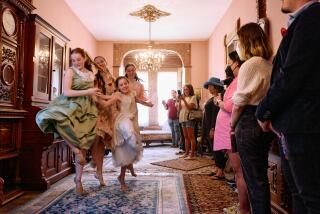Taking Flight, Finally
- Share via
On the afternoon of Nov. 2, 1974, this reviewer waited in Shrine Auditorium with a theaterful of others for the Royal Swedish Ballet to dance “Swan Lake,” a performance eventually canceled due to a combination of dancer injury and other factors. The company has now opened a six-day engagement at the Orange County Performing Arts Center with that same production, proving that if you wait long enough. . . .
Unfortunately, some of the long wait for this “Swan Lake” took place inside the Orange County Performing Arts Center on Tuesday: With three generous intermissions, the ballet took 3 1/2 hours to reach its dreadfully over-literal happy ending. Indeed, a tendency to doggedly explain the self-evident continually weakened Natalie Conus’ Bolshoi-influenced staging. It was created in 1964, three years before the first full-length version by American Ballet Theatre, and it maintains just as strong a focus on making the storytelling and character relationships clear and vivid enough to support a full load of classical and character divertissements.
In pursuit of that goal, some of Conus’ innovations prove exceptionally thoughtful: a Jester who, for once, actually jests; a Tutor who really teaches; and, most of all, what may be the most successful attempt anywhere to turn the mime role of the evil sorcerer Rothbart into a major dancing assignment without the ghastly, wing-flapping overkill that such an intention usually inspires. Yes, Conus stumbles badly at the end--relying on costume effects rather than dancing or acting to depict Rothbart’s destruction and Odette’s salvation--and, yes, some of her ingenuity clashes with the music. But this reviewer is inclined to be far more accepting of her lapses than he would have been at the Shrine in 1974. We have all seen much worse since.
Moreover, the Royal Swedish Ballet is itself a godsend, reminding local audiences what a corps de ballet should look like, what character dances should look like, what mime should look like. Conus has filled the choreographic text with technical complexities that link Imperial Russian tradition with 20th century Soviet style, and the Swedes have added their own warmth and charm. The women, in particular, make it all look so easy that it takes a heart-stopping balance in the Pas de Trois coda for you to notice Nadja Sellrup as somebody special.
In the same Act 1 trio, Judith Simon breezes through intricate legwork and Olof Westring tosses off some effortless air turns--though he and nearly all the other male soloists Tuesday suffered from rocky terminations sooner or later. As the Jester, the deft Jens Rosen makes his shaky finishes into a joke, but only Joakim Stephenson as Rothbart upholds Viking honor by nailing every step, with noble line and unstinting intensity also distinguishing his performance.
As Siegfried, Jan-Erik Wikstrom is no virtuoso but partners strongly and makes deeply credible the character’s change from party boy to Hamlet-like melancholy prince. However Marie Lindqvist looks far more comfortable when dancing fleetly as a deceptively carefree Odile than playing tragic as a tense, weepy Odette--and executing her lyric choreography expertly but with no great involvement. Moreover, the decision to place her in a short, classical tutu with the other 25 swans wearing long, Romantic-style skirts makes her seem out of place, as if she’s wandered in from another production.
Both David Walker’s costumes and Henry Bardon’s sets link this 226-year-old Royal Ballet to the 20th century Royal upstart in London, enforcing an autumnal elegance that conductor Renat Salavatov also manages to sustain in a tolerably secure performance by the Pacific Symphony. A quarter-century ago, we might have taken all this care and professionalism for granted; right now the dismal state of “Swan Lake” on world stages suggests we’d better get it while we can.
More to Read
The biggest entertainment stories
Get our big stories about Hollywood, film, television, music, arts, culture and more right in your inbox as soon as they publish.
You may occasionally receive promotional content from the Los Angeles Times.










